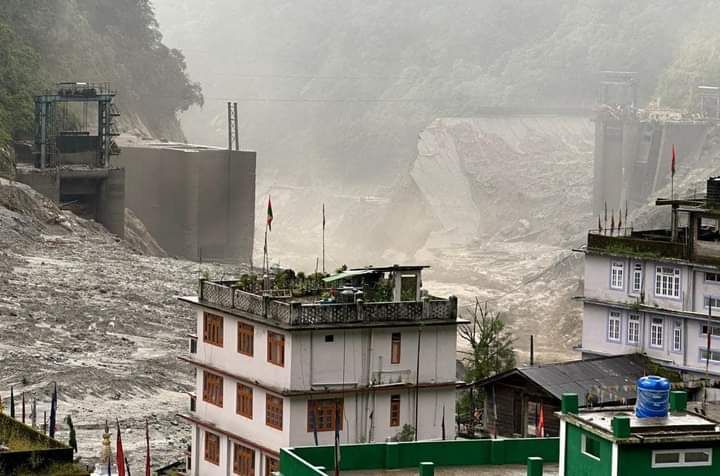The climate crisis is melting ice in the Himalayas, threatening to overflow glacial lakes as the Indian government rushes to build new dams.
By Olivia Rosane. Published 10-6-2023 by Common Dreams

Authorities raised the death toll to 42 on Friday after a glacial lake overwhelmed a dam in the Indian Himalayas earlier this week, in one of the worst disasters in the area in nearly half a century.
The dam breach on Wednesday, which was caused in part by extreme rainfall, had long been predicted by scientists and environmental advocates due both to the climate crisis and inadequate regulations.
“We knew that this was coming,” Gyatso Lepcha, general secretary of local environmental group Affected Citizens of Teesta, said in a statement reported by The Associated Press.
The flooding occurred in India’s Sikkim state after South Llonak Lake overflowed and breached the state’s largest dam, AP reported further.
It seems that the Chungthang Dam (Teesta III Hydropower project) on the Teesta has been breached this morning.
— Siddharth Agarwal (@sidagarwal) October 4, 2023
Scary visuals floating around. Civilians and army personnel are missing. Lots of immediate assistance and long term re-thinking required. #Sikkim #Teesta #Rivers pic.twitter.com/u3ajHy2h7r
“Floodwaters have caused havoc in four districts of the state, sweeping away people, roads, bridges,” Indian Army spokesperson Himanshu Tiwari told AFP.
The floodwaters destroyed 15 bridges, according to Reuters, and damaged or flattened more than 270 homes, AP reported.
State official Tseten Bhutia said that around 2,400 people had been rescued and 7,600 were living in emergency settlements, according to Reuters. Overall, the Sikkim government said that the disaster impacted a total of 22,000 people.
“We got calls from people that river levels could rise at 3 am and we ran for our lives,” 44-year-old Javed Ahmed Ansari, a Teesta valley river-rafting business owner, told Reuters. “We ran towards the hill in the jungle… We saw houses getting swept away. I can now only see the first floor of our house which is filled with sand, everything is submerged.”
Officials said Friday that at least 42 people had died and 142 were still missing. After the flood, satellite photos revealed the lake had diminished by two-thirds, according to reporting by CBS and AFP.
Very scary visuals coming in from Sikkim after a flash flood occurred in the Teesta river in Lachen valley caused due to a sudden cloud burst over Lhonak Lake in north Sikkim. pic.twitter.com/rd74qS32uQ
— Nistula Hebbar (@nistula) October 4, 2023
The immediate cause of the flooding may be a combination of both a burst of extreme rainfall and a 6.2 magnitude earthquake in neighboring Nepal on Tuesday, according to AP. However, it is exactly the kind of disaster that scientists have warned about as the climate crisis melts Himalayan glaciers, swelling the waters of glacial lakes. South Llonak Lake had been growing faster than any other lake in Sikkim, scientists warned in a 2021 study.
“It was already predicted in 2021 that this lake would breach and impact the dam,” Indian Institute of Technology, Indore, glaciologist Farooq Azam toldCBS News. “There has been a substantial increase in the number of glacial lakes as the glaciers are melting due to global warming.”
In general, mountain regions are melting twice as fast as the global average due primarily to the burning of fossil fuels. A study published in June found that the Hindu Kush Himalayas could lose 80% of their ice by 2100 if countries don’t rapidly phase out oil, gas, and coal. In addition to triggering glacial floods, this would threaten the drinking water source relied on by 2 billion people.
This loss is clashing with the Indian government’s attempt to transition to renewable energy by increasing hydroelectric power by 50% by the end of the decade, according to AP. To meet this goal, the government has signed off on hundreds of dams in the Himalayas, but a 2016 study warned that more than 20% of 177 dams in five Himalayan nations were at risk from breaches caused by the overflowing of glacial lakes.
That list included the dam that breached Wednesday, the Teesta 3 hydropower project, which began operating in 2017 after nine years of work. Local watchdog groups had also expressed concerns about its lack of safety features.
“Despite being the biggest project in the state, there were no early warning systems installed even though the glacier overflowing was a known risk,” Himanshu Thakkar of South Asian Network for Rivers, Dams, and People told AP.
Wednesday’s disaster follows another dam breach in 2021 that killed 81 people in Uttarakhand state. India’s National Disaster Management Agency promised Friday to fit most of the country’s 56 at-risk glacial lakes with earning warning systems.
Extreme rainfall triggered by the climate crisis is also proving deadly in India and around the world, with more than 100 killed in northern India in July and nearly 50 in Himachal Pradesh in August.
“Intense rain has led to this catastrophic situation in Sikkim where the rain has triggered a glacial lake outburst flood and damaged a dam, and caused loss of life,” International Centre for Integrated Mountain Development ice researcher Miriam Jackson told reporters. “We observe that such extreme events increase in frequency as the climate continues to warm and takes us into unknown territory.”
This work is licensed under Creative Commons (CC BY-NC-ND 3.0).

